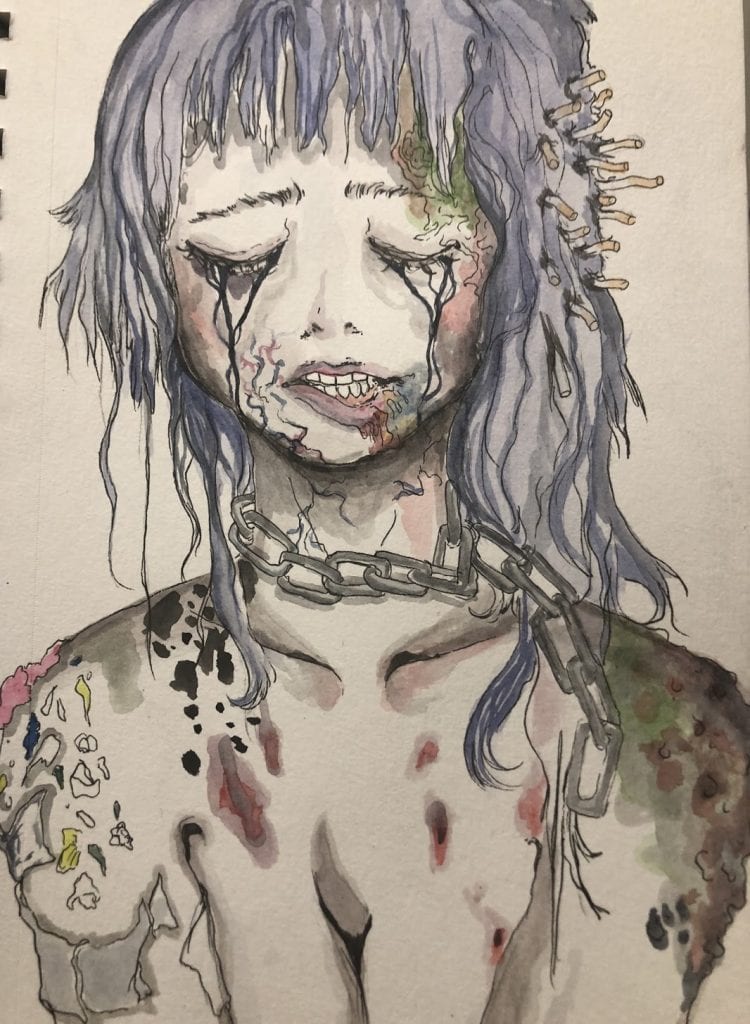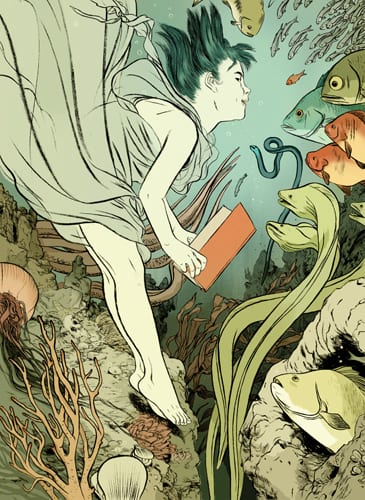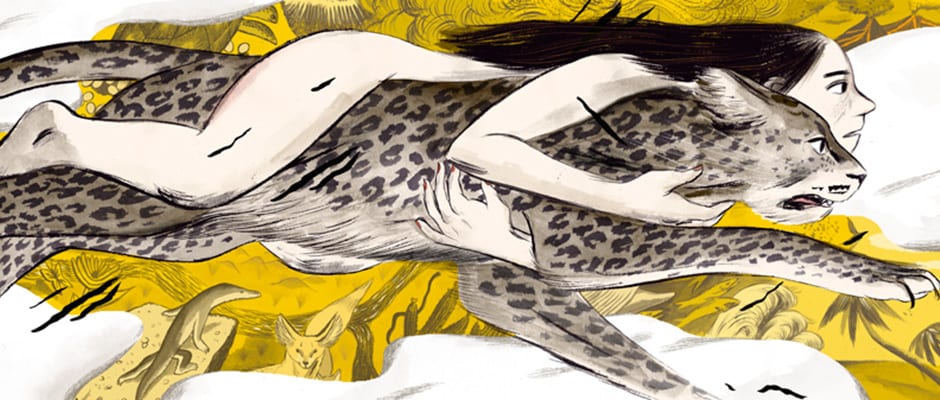This piece is a representation of how a male dominated society has erased and dismissed women as people who deserve equal rights. I wanted to showcase pollution in the environment on a woman, giving a visual on the psychological damage of misogyny as a whole. My inspiration for this piece came from experimental brainstorming and female illustrators as role models for a new generation of females.
Jillian Tamaki- An inspiration for female illustrators
Essay:
Jillian Tamaki as a Role Model
Art has always been my passion. Since the age of four I would create my own picture books by pulling out paper from my moms office printer. I went from waxy crayons and stiff colored pencils, to my very first art kit I got for my birthday in the 2nd grade, including a variety of paint, oil pastels, and pencils, aligned in a sea of gradient organized color. I felt passionate and happy creating stories through illustrations, whether it was a slice of life, or a fictional adventure extracted from my creative child mind. When creativity is freed with the tools such as a pen and paper, there is a whole world of possibilities that can unfold. It’s what you choose to do with your craft that matters. The power of visuals can represent a new idea or a political stance in a different point of view, that lets people see situations through your lens, while speaking for the many people looking for a voice.
Jillian Tamaki is a cartoonist and illustrator from Calgary, Alberta, and is now living in Toronto, Ontario. She co-created two of her graphic novels with her cousin, Mariko Tamaki. This includes their graphic novel, “This One Summer” which one a Governor General’s Award and Caldecott Honor. Jillian has been a professional illustrator since 2003, after graduating from Alberta College of Art and Design. She is well know for her short comics, editorials, children’s book illustrations, Storyboards for cartoons including Adventure Time, and even taught at Parsons and School of visual arts. Jillian’s inspiring work has earned her many other awards including Gold Medal, New York Times, and Society of Publication Designers. She has done work for The New Yorker, Washington post, Chronicle Books, and many more. Her success as a female illustrator has made an amazing impact for the art industry and illustration community.
She has inspired many young girls interested in her field, to create and believe in themselves, and that there voice, can reach the world through their craft. Her contributions to different publishers has been positive with her beautifully drawn illustrations to complement interesting stories, biographies children’s books and political topics.
Tamaki’s work has recurring themes and topics within them. Feminism, freedom of expression, and activism are a few. “This One Summer” is a slice of life graphic novel about an adolescent girl and going on vacation with her parents to their family friends summer cottage, where she meets her family friend. The novel depicts innocence within young girls going through changes, and recognizing the complexity of adults around them. Rape, misogyny, and the environment are discussed within the story.
Jillian’s unique style and underrated yet relatable references and voices that she includes in her work been an inspiration to me for a while. I admire her experimentation with different styles and topics while staying consistent with her own style and a solid medium. That’s an important skill while developing into an artist over time. Her beautiful brush strokes and intricate detail shows the amount of time and appreciation that she puts into her work. With art, there is always trial and error, likes and dislikes, and hopes to improve. Embracing flaws within your collection of work should be embraced. Tamaki quotes; “If there aren’t some bad drawings in your sketchbook, then you’re probably doing it wrong.”
Females who work in the Art Industry are an important part of and changes the way people see everyday issues and points of view that have been discarded and dismissed in a patriarchal society. The experiences that women recreate through visuals and text opens a world of relatable and unjustified problems. Since art became a part of our history, like almost every profession in the world, it has been male dominated and still is to some degree today.
Women overtake the majority of art schools yet they are still underrepresented in media and industry. It is also shown that women in the art industry are paid significantly less than men, whether it be animators, designers, directors or many others. Female artists are often rejected for not following social art norms according male dominated industries. The opinions of women matter always. If that cannot be acknowledged through art then how can we ever here their voices, listen to their struggles, recognize their intelligence and ability to be strong entrepreneurs? This why it’s important to encourage younger generations to stand for change,.and to create new ideas. Appreciation and motivation towards female artists should always be encouraged.
Art is a subjective and character driven world. Most people who aren’t familiar on the importance of art can’t always see through an opened mind, especially within the illustration community. When people look at comics, graphic novels, cartoons, and portraits, they tend to view it as people getting paid to play around, or “art’s and crafts.” In reality, it can be true that we as artist get paid to have fun, which is amazing. Yet, there is a lot of time, work, brainstorming, and significance that goes into making a good piece of work. The concepts are powerful and can hold huge messages to change the world and bash common ignorance.
Going to art school to pursue your dream to create amazing work, should not be shrugged off as a waste of an opportunity. You never know what sort of revolutionary creations can unfold, through a diverse, new generation of women.



